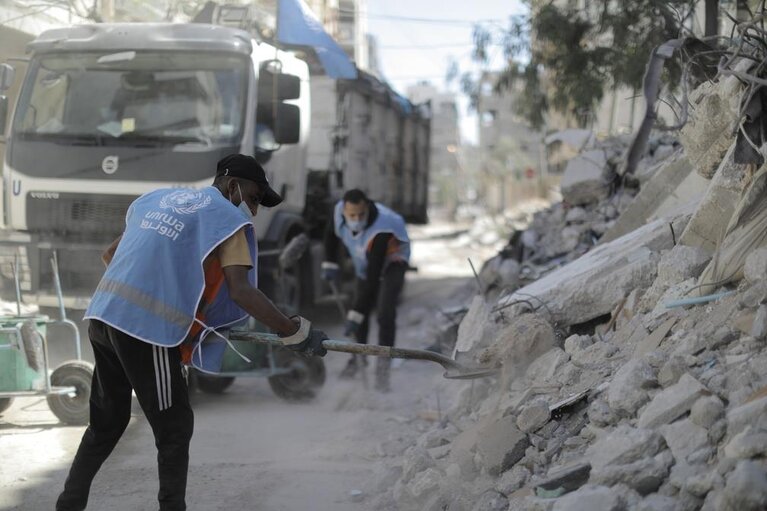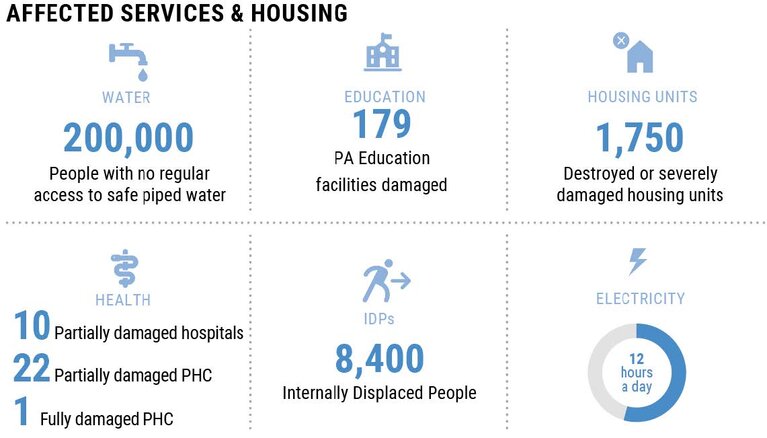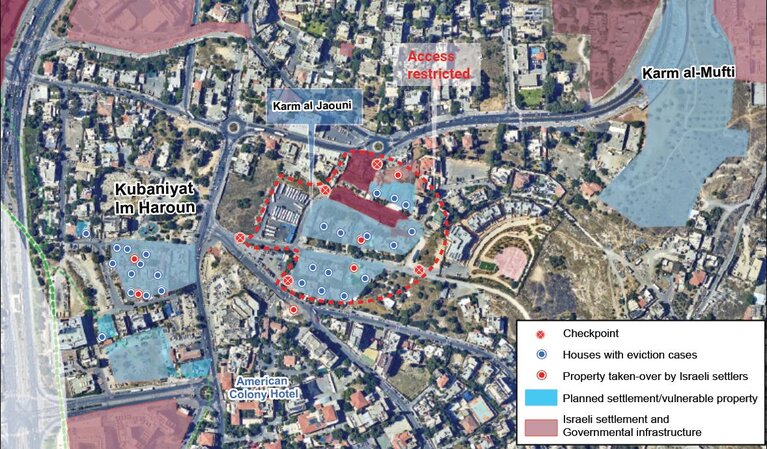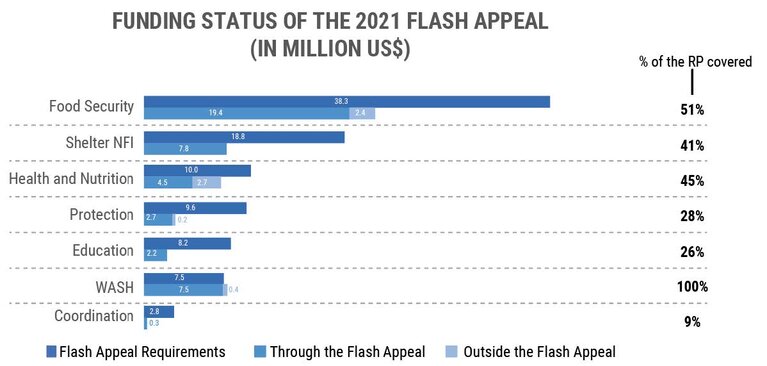Response to the escalation in the oPt | Situation Report No. 5 (18-24 June 2021)
Highlights
- In Gaza, about 8,400 internally displaced people (IDPs) remain with host families and in two UNRWA schools.
- The Israeli authorities have eased the export/transfer of goods from Gaza, the movement of Palestinians through the Erez crossing and extended the fishing limit.
- Clashes continued across the West Bank, including in East Jerusalem, with continuing protests in the Nablus village of Beita accounting for the vast majority of injuries.
- The humanitarian community has raised US$43.5 million of the $95 million requested in the emergency response plan to support 1.1 million Palestinians for three months.
Situation overview
Gaza Strip
The ceasefire is largely holding, with an almost complete halt in the launching of incendiary balloons by Palestinians towards Israel and the night protests near the perimeter fence with Israel since 20 June. According to the Office of the High Commissioner for Human Rights (OHCHR), during the escalation, 260 Palestinians, including 66 children and 41 women were killed in Gaza, of whom 129 are believed to be civilians, 64 members of armed groups, and 67 are undetermined. About 249 of these, including 63 children and 41 women, were seemingly killed by Israeli Forces. Over 2,200 Palestinians were injured during the hostilities, including 685 children and 480 women, some of whom may suffer from a long-term disability requiring rehabilitation.
At the height of the escalation, 113,000 IDPs sought shelter and protection at UNRWA schools or with hosting families. There are still about 8,400 IDPs, including 247 people in two UNRWA schools, primarily those whose houses were destroyed or were so severely damaged as to be uninhabitable, and who do not have resources for renting. According to the local authorities, some 1,770 housing units were destroyed or severely damaged, in addition to an estimated 25,620 housing units sustained partial damage, as did multiple water and sanitation facilities and infrastructure, 179 government schools and 33 health facilities.
Although most damaged electricity feeder lines and networks have been reconnected, electricity is available for only 12 hours per day across Gaza, due to the disruption to some lines and insufficient fuel for the Gaza Power Plant, which continues to be totally reliant on Egyptian-imported fuel purchased on the local market.
As of 23 June, the Israeli authorities eased some of the restrictions to allow for the departure of patients with Israeli-issued permits for life-saving treatment unavailable in Gaza, as well as the exit of Palestinians to visit terminally ill relatives, or those who need longer-term treatment. In addition, all Palestinians whose return to Gaza was prevented by the Israeli authorities, are reportedly allowed to re-enter. However, the vast majority of Palestinians in Gaza remain prohibited from exiting, as has been the case at least since the imposition of the blockade 14 years ago. The Israeli authorities have also extended the fishing limit to up to nine nautical miles off the Gaza coast.
As of 21 June, the Israeli authorities allowed a limited number of agricultural commodities and textiles to be exported abroad or transferred to the West Bank through the Kerem Shalom commercial crossing for the first time since the escalation. The export of goods to Israel remains prohibited. Kerem Shalom remains open for the entry of specific basic commodities, including food, animal fodder and medical supplies, as well as fuel for the private sector and for UNRWA. In addition, postal mail is now allowed to enter and exit Gaza. On 24 June, the Ministry of Agriculture in Gaza reported that farmers have halted the export of agricultural produce to Israel, due to new conditions imposed by Israel on the exit of tomatoes.
Aid, including food and medicine from Egypt and other countries, continue to enter through the Rafah crossing on most days. The crossing is also open for the entry and exit of authorized travellers, including Palestinians injured in the recent escalation who are receiving medical treatment in Egypt. The Egyptian authorities are also allowing food, fuel and construction materials to enter Gaza through the Salah Ad Din gate.
West Bank, including East Jerusalem
During the reporting period, Palestinians continued to protest against Israeli settlements and other Israeli policies across the West Bank, including East Jerusalem, and Israeli forces responded with crowd-controlled measures, injuring at least 430 Palestinians, including 144 children. Beita village in Nablus accounted for the vast majority of casualties, with at least 400 Palestinians, including at least 140 children, injured by Israeli forces during protests against the construction of a new Israeli settlement on land belonging to the residents of the village.
On 21 June, hundreds of Israeli settlers participated in marches across the West Bank, to protest Palestinian construction in Area C. In Salfit, settlers reportedly uprooted tree saplings, vandalized trees and destroyed an irrigation system. In other incidents, Israeli settlers threw stones and injured two Palestinian women, including a 73-year-old disabled woman, in At Tawani, Hebron; and reportedly bulldozed about 300 dunums of land and set fire to at least 15 olive trees in Nilin, Ramallah.
During the reporting period, 39 Palestinians, including three children, were arrested by Israeli forces in East Jerusalem.
Sheikh Jarrah
Palestinian families still face the threat of forced eviction by the Israeli authorities from their homes in the Karm Al Jaouni area of Sheikh Jarrah, East Jerusalem, due to court cases initiated by Israeli settler organizations. The High Court of Justice is set to hold a hearing on 2 August regarding the forced eviction of four families.
Since 3 May, Israeli forces have been stationed at all five entrances to Karm Al Jaouni, allowing entry only to Palestinian neighbourhood residents, who are ordered to present identifying documents, as well as to Israeli settlers, journalists, ambulances and UN vehicles. According to the community, access by Israeli settlers has been permitted without ID checks by Israeli forces.
During the reporting period, Israeli settlers threw stones and pepper-sprayed Palestinian residents and Palestinians threw objects at settlers. Some Palestinians also threw objects including, according to media reports, a Molotov cocktail. In some incidents, Israeli forces intervened with tear gas, stun grenades, rubber bullets and skunk water, injuring 20 Palestinians and arresting three. On 20 June, an Israeli settler pepper-sprayed four Palestinian girls (aged between 12 and 14), who were transferred to a hospital for treatment. Following the incident, Israeli forces arrested two Palestinians, including one child. Israeli forces also arrested two Palestinians in three Palestinian homes in Karm Al Jaouni, in operations during which they used stun grenades, tear gas canisters and skunk water, triggering clashes with residents and reportedly injuring some residents and causing damage to property. On 22 June, humanitarian partners met with residents to offer protective measures in response to the continued violence in the neighbourhood, especially during late hours.
Funding
As reported previously, on 27 May, the Humanitarian Coordinator for the OPT, Lynn Hastings, launched the inter-agency Flash Appeal, requesting $95 million to support emergency humanitarian and early recovery responses over a three-month period. The response plan envisages a swift transition to an early recovery phase, including the rehabilitation and reconstruction of infrastructure services and networks, and then to a medium- and long-term reconstruction and recovery framework. The plan complements the $417 million appealed for in the 2021 OPT Humanitarian Response Plan, covering pre-existing humanitarian needs.
So far, $43.5 million, or 46 per cent per cent of the amount requested in the Flash Appeal has been raised. Including resources outside the Flash Appeal, $49 million have been mobilized in support of humanitarian response activities in the OPT.
Also, before the reporting period, the Humanitarian Coordinator released $18 million from the OPT Humanitarian Fund, with 95 per cent of the funding allocated to Gaza, and five per cent to health, protection and shelter activities in the West Bank. The Emergency Relief Coordinator in New York released $4.5 for the Gaza humanitarian response, including for the safe removal of explosive remnants of war (ERW), rental subsidies for refugees whose homes were destroyed, and the restoration of basic services such as health care and water.
Total funding for Flash Appeal response by donors
|
Donor |
Inside the Response Plan |
Outside the Response Plan |
Total in US$ |
|
OPT HF |
18,000,000 |
|
18,000,000 |
|
ECHO |
4,700,000 |
500,000 |
5,200,000 |
|
CERF |
4,500,000 |
|
4,500,000 |
|
Germany |
4,300,000 |
|
4,300,000 |
|
Japan |
3,000,000 |
|
3,000,000 |
|
UAE |
2,700,000 |
|
2,700,000 |
|
Canada |
2,320,000 |
|
2,320,000 |
|
CDCS - Le Centre de Crise et de Soutien |
1,024,000 |
714,970 |
1,738,970 |
|
WHO |
|
1,200,000 |
1,200,000 |
|
World Bank |
|
1,000,000 |
1,000,000 |
|
Norway |
954,000 |
241,800 |
1,195,800 |
|
Other funding* |
2,833,265 |
2,028,271 |
4,861,536 |
|
Grand Total |
44,331,265 |
5,685,041 |
50,016,306 |
| *Other funding includes contributions from donors in the amount below US$900,00, as follows: AECID, Alliance 2015, Anera, Bank of Palestine, Danida Emergency Response Fund (DERF), Diakonia/NAD, Fundo Alava Emergencia, Human Appeal – UK, Islamic Relief Worldwide, MDM, Oxfam, Qatar Charity, Qatar Red Crescent (QRC), Save the Children International, Secours Islamique France (SIF), SIDA, Swiss Solidarity, UNICEF. | |||
COVID-19
As of 24 June, the number of people confirmed to currently have COVID-19 across the OPT was 2,985, down from 3,584 last week. Since the outbreak began in the OPT, about 335,000 of the 341,856 cases have recovered, and 3,823 have died. The number of patients in intensive care units is six, with two people requiring mechanical ventilation. Twelve patients are being treated in Corona hospital centres and departments in the West Bank. The Case Fatality Rate (CFR), the proportion of deaths among confirmed cases, remains at 1.1 per cent.
In Gaza, as of 24 June, some 2,818 active cases were reported, down from 3,317 last week, who were isolated either at home or in hospitals designated for COVID-19 treatment by the MoH. The cumulative number of COVID-19 cases is 113,607, with 109,733 people recovered, and 1,056 deaths recorded. Gaza now accounts for 94 per cent of all active cases in the OPT.
The West Bank continues to witness a decline in confirmed COVID-19 cases and in related deaths. As of 17 June, about 460,000 Palestinians have been vaccinated, including about 110,000 Palestinian workers who have been vaccinated by the Israeli authorities.
For latest WHO COVID-19 update, see here.
Vaccine Tracking (as of 18 June 2021)
| Status: Arrived from all sources: 845,100 doses in total | |||
| Vaccine | No. of doses | Source | Notes |
| Moderna | 4,500 | IL | Donation |
| Sputnik V | 10,000 | RU | Donation – 2,000 doses were sent to Gaza |
| 60,000 | UAE | Donation to Gaza only. Last shipment of 40,000 doses arrived 12-Mar-2021 |
|
| 20,000 | RU | Donation. Delivered to the W | |
| 130,000 | PA | PA purchase. Delivered. | |
| Sputnik light | 100,000 | PA | Arrived 12 June 2021 – 100,000 PA bilateral purchase from Gamaleya |
| 29,200 | UAE | Arrived 12 June 2021 – 29,200 donation to Gaza from UAE | |
| AZ SK Bio | 168,000 | COVAX | Phase 1 (168,000 doses): First shipment (1 of 3) 24,000 doses arrived 16 March 2021: WB-14,400; Gaza – 9,600 Second shipment (2 of 3) 72,000 doses arrived 19 April 2021: WB – 43,200; Gaza – 28,800 Third shipment (3 of 3) of estimated 72,000 doses: (Gaza – 9,600 and WB – 62,400). Additional doses for Gaza expected to be sent from Nablus in June from this shipment at the request of Gaza |
| Pfizer | 37,440 | COVAX | Arrived 17 Mar 2021. The shipment delivered to WB- 25,740 and Gaza - 11,700 |
| Pfizer | 102,960 | COVAX | WB-56,160 doses; Gaza – 46,800 doses |
| Sinopharm | 100,000 | China | Donation arrived 29 Mar 2021. delivered to Nablus Cold Store. 10,000 delivered to Gaza. |
| Sinopharm | 10,000 | Jordan | Donation to Gaza |
| AZ SII | 25,000 | PA MoH | Arrived 30 Mar 2021 - PA Bilateral purchase from AZ - Serum Institute of India |
| AZ R-Pharm | 48,000 | PA MoH | Arrived 13 April 2021 – PA bilateral purchase from AZ-R-Pharm |
| Status: In pipeline: Donation (estimated) | |||
| Vaccine | No. of doses | Source | Notes |
| Sinopharm | 25,000 | Jordan | Bilateral donation from Jordanian private company |
| Sputnik V | 10,000 | UAE | Donation to Gaza |
| Status: In ipeline: Bilateral Deals (estimated) | |||
| Vaccine | No. of doses | Source | Notes |
| AZ-Russia | 2,000,000 | PA purchase | In progress (48,000 doses delivered 13 April, see above) PA MOH reports this deal is cancelled (to be verified) |
| Pfizer | 4,000,000 | PA purchase | MoH confirmed in a meeting with WHO that the deal is concluded. 205,000 doses expected Q2; 1.8 million Q3 and 2.0 million Q4 |
| Sputnik V | 500,000 | PA purchase | Under negotiation |
Humanitarian response & ongoing needs
Protection
Priority needs
- There is an urgent need to scale up psychosocial support (PSS) activities for children and families, including non-structural recreational activities and open days, as well as providing cash, including voucher assistance. Cluster partners continue to report a large volume of calls to the national helpline. One partner-run helpline received over 22,582 calls in June so far and responded to about 20 per cent.
- Children, caregivers, teachers, and counsellors are all in need of mental health and psychosocial support (MHPSS), and recreational and stress relief activities, including positive parenting skills. The need to educate civilians, especially children, about recognizing and mitigating explosive risks remains urgent, particularly for IDPs, rubble removers and scrap metal collectors.
Responses already implemented
- Between 11 and 17 June, Cluster partners provided 663 counselling sessions to people across the OPT by a national helpline, with 600 sessions (or 90 per cent) provided in Gaza, including 200 to children. In Gaza, Cluster partners continued providing 323 MHPSS sessions, including to some 50 children. In total, some 1,230 telephone counselling sessions have been provided.
- Cluster partners provided psychological first aid (PFA) and recreational activities to some 126 children and structured PSS activities, including individual and group counselling sessions, to some 174 children. Specialized child protection case management services were provided to 34 children and ERW awareness raising sessions and messages to another 233 beneficiaries.
- During the reporting period, UNMAS carried out an explosive ordnance disposal (EOD) response and removed one ERW. Some 330 explosive ordnance risk education sessions were carried out, reaching 1,014 people, in addition to eight classroom sessions, reaching about 150 people, including 66 UNRWA coordinators.
- UN personnel received trainings on several types of medical trainings, including emergency trauma bag and basic first aid kit.
- In the West Bank, including East Jerusalem, partners continued providing legal assistance to arrested children.
- Cluster partners continue providing structured psychosocial support activities, including education support and sports sessions to some 760 children. Another 14 mothers and female caregivers received positive parenting sessions. In Salfit and Hebron, 71 children received psychosocial support through a rehabilitation programme for children affected by the conflict.
Key constraints/gaps
- Infrastructure damage alongside recurrent electricity cuts and internet disconnection across Gaza is undermining outreach and remote services.
- In the West Bank, including East Jerusalem, access remains a key challenge due to closures of village entrances by Israeli forces, checkpoints, Israeli settler demonstrations and sporadic clashes. The absence of international protective presence, due to COVID-19-related travel restrictions, remains a major concern.
- Adequate funding has yet to be identified to deliver needed mine action tasks.
- In Gaza, the COVID-19 measures impede reaching children and families with face-to-face interventions.
Health
Priority needs
- Trauma and emergency care, including the pre-positioning of supplies.
- MHPSS support.
- Access to essential health services, including primary health care, maternal and child health, non-communicable disease management, sexual and reproductive health, and COVID-19 response.
- Stronger partner coordination and information management.
Responses already implemented
- Partners continue to mobilize resources for the procurement and supply of some essential drugs, disposables and equipment for responding to current needs, as well as pre-positioning.
- A Gaza Health Cluster meeting was held focusing on the current situation and responses.
- Response activities related to COVID-19 have-intensified, including diagnostics, case management, infection prevention and vaccinations.
- Partners have continued to provide first aid and emergency services to those injured in clashes across the West Bank, including East Jerusalem.
Key constraints/gaps
- Insufficient funding.
Shelter
Priority needs
- Temporary shelter solutions for IDPs through cash assistance, alongside support for host families.
- Repair of uninhabitable homes to reduce displacement and meet the growing need for homes.
- Repair of damaged homes and assistance for the most vulnerable, including female-headed households, the elderly, and persons with disabilities.
- Provision of essential non-food items.
Responses already implemented
- Coordination with the relevant local authorities to better estimate the number of housing units destroyed or damaged and the number of IDPs.
- Since the start of the escalation, NFIs kits, hygiene kits, e-vouchers and multipurpose cash have been distributed to some 5,500 households.
Key constraints/gaps
- Inadequate access to construction materials, due to import restrictions on Gaza.
- Longstanding housing shortage in Gaza makes rent unaffordable for displaced families.
- IDPs are at a higher risk of contracting COVID-19, due to overcrowding and the use of shared facilities.
Funding
- The United Nations Development Programme has secured about $1.75 million to cover temporary shelter cash assistance and cash support, including for some 500 families with destroyed or otherwise uninhabitable homes, until the end of June 2022.
Education
Priority needs
- Supporting the MHPSS well-being of students, parents, and educators in Gaza.
- Ensuring that children can access safe and inclusive learning opportunities through the emergency repair of education facilities and the provision of non-formal education services during the summer break.
- Rehabilitation of 59 UNRWA schools used as temporary shelters, before they can re-open in August.
Responses already implemented
- The findings of a school assessment carried out by the Palestinian Authority (PA) were disseminated to relevant stakeholders. Assessments of private schools, higher education facilities and kindergartens are ongoing.
- The Cluster has established temporary thematic working groups to coordinate the school rehabilitation response and summer programmes for vulnerable children. This includes the provision of MHPSS services and remedial education.
- The minimum standards for summer programmes are being developed and will be circulated to all implementing partners to coordinate summer activities among the various service providers.
- Partners are implementing remote MHPSS interventions, targeting children and their caregivers.
Key constraints/gaps
- Children’s ability to access education, both at school and at home, is undermined by Gaza’s chronic electricity deficit, worsened due to the escalation. Electricity cuts particularly undermine the 12th grade examination process, which started on 24 June.
- The timeframe for rehabilitating schools in Gaza, considering the new academic year begins in mid-August.
- Insufficient funding allocated for Education in Emergencies, including the rehabilitation of education facilities and for summer activities.
Funding
- Some $1.8 million allocated from Education Cannot Wait to UNRWA and UNICEF to rehabilitate damaged schools and implement summer programmes.
Water, Sanitation and Hygiene (WASH)
Priority needs
- Rapid repair of affected WASH infrastructures so that water and sanitation services in the most vulnerable communities can be restored.
- Support critical WASH facilities, such as water desalination plants, wastewater treatment plants, sewer and water pumping station by providing operational and maintenance materials.
- Provide IDPs and host families with hygiene items.
Responses already implemented
- In Gaza, partners are delivering 450,000 litres of emergency fuel, chemicals and chlorine to support the operation of 289 main WASH facilities, benefitting over 1.2 million people.
- Partners are providing 12,500 households with trucked water, hygiene material and other WASH items.
- Partners are coordinating with the Ministry of Social Development (MOSD) and the Shelter Cluster to target 1,760 families in Gaza with the rapid rehabilitation of household WASH facilities.
Key constraints/gaps
- In Gaza, some 200,000 people are lacking regular access to safe piped water, due to damage caused to WASH infrastructure during the escalation.
- WASH service providers in Gaza report that their stocks of maintenance materials are running out, including materials that Cluster partners supplied prior to the escalation as emergency preparedness measures.
Funding
- WASH Cluster partners have secured $6.2 million, targeting 600,000 people.
Food Security
Priority needs
- In Gaza, ensure the opening of Kerem Shalom crossing to ensure entry and exit of agricultural inputs and products.
- Expanding the fishing zone for fishermen from nine up to 20 nautical miles.
- Rehabilitate damaged agricultural facilities, including water wells, irrigation systems, greenhouses, and livestock farms.
- Conduct a needs assessment of agricultural damage and losses.
- Provide food assistance to IDPs and other new and existing food-insecure people.
- Conduct an inventory of the stored pesticides and fertilizers that were destroyed.
- Provide assistance to rebuild the productive capacities of small holders and small food factories (conditional cash-for-work activity).
Responses already implemented
- An initial assessment by the Ministry of Agriculture of damage to agricultural wells, ponds, reservoirs, greenhouses, and livestock farms, amounting to $204 million, is ongoing.
- Cluster partners continued providing cash assistance, in the form of food e-vouchers and multipurpose cash assistance to over 130,000 people to the value of $3 million.
- Cluster partners have supported nearly 300,000 people in need in Gaza through emergency e-voucher assistance and in-kind food assistance.
- Cluster partners are providing the remaining IDPs in emergency shelters with food items until the end of June.
Key constraints/gaps
- Funding gaps are hindering the rehabilitation of damaged agricultural facilities.
- WFP requires some $24 million to continue providing regular food assistance to over 435,000 vulnerable people in the OPT until November 2021. Another $9.3 million is needed to provide emergency and recovery assistance over the coming three months for affected people in Gaza.
- Power shortages, coupled with damage to solar powered systems, are hindering farmers from irrigating their crops and breeders from providing water to livestock and poultry.
- The nine nautical mile fishing restriction is limiting fisher livelihoods.
Funding
- FAO has secured $610,000 to provide urgent fodder to affected breeders. Another $1 million is allocated for the same purpose through the Humanitarian Fund.
- WFP received a contribution of $2.7 million from the United Arab Emirates, EUR 500,000 from France and $6.5 million from Germany.
Coordination and support services
Priority needs
- Deliveries of life-saving humanitarian items into Gaza, including medicine and medical supplies, vaccines, food commodities, first aid kits and fire extinguishers. The Logistics Sector will hold a meeting on 29 June with relevant UN and NGO colleagues to better understand the reasons for the back-log and to intervene with the parties concerned to facilitate the entry of these shipments into Gaza.
Responses already implemented
- The Logistics Cluster continued following up on the Kerem Shalom Crossing and the number of trucks crossing for the private sector. Between 17 and 22 June, 480 trucks entered Gaza, containing fuel, medical supplies and materials for human and animal consumption.
Key constraints/gaps
- The restrictions on the border crossings remain a major challenge.













